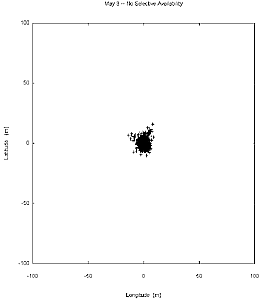 |
GPS SYSTEMS |
 |
 |
GPS SYSTEMS |
 |
The GPS system has been designed to be as accurate as possible. However, there are still some errors. Put together, these errors can cause a misreading that is off by 50 to 100 meters from the actual GPS receiver position. There are several reasons for these errors:
Atmospheric Conditions
The ionosphere and troposphere both refract the signals. This causes the speed of the signal in the ionosphere and troposphere to be different from the speed of the signal in space. Therefore, the distance calculated from "Signal Speed x Time" will be different for the portion of the signal path that passes through the ionosphere and troposphere compared to the portion that passes through space. The ionosphere is the layer of the atmosphere from 30 to 300 miles that consists of ionized air. The troposphere is the lower part (ground level to 5-8 miles) of the atmosphere that experiences the changes in temperature, pressure, and humidity associated with the weather.
Ephemeris Errors/Clock Drift/Measurement Noise
The satellite's signals contain information about ephemeris (orbital position) errors, and about the rate of clock drift for the broadcasting satellite. The data concerning these errors may not exactly model the true satellite motion or the exact rate of clock drift. Distortion of the signal by measurement noise, can further increase positional error.
Selective Availability
Ephemeris errors should not be confused with Selective Availability (SA), which is the intentional alteration of the time and epherimis signal by the Department of Defense. Basically, the government messed with your signals so no matter what you did you wouldn't be very accurate. Todays receivers, without the government-imposed Selective Availability programs regulations, are accurate to within approximately 15 meters. The SA was intended to prevent military adversaries from using the highly accurate GPS signals. The government turned off SA in May 2000, which significantly improved the accuracy of civilian receivers.


| Source | Uncorrected Error Level | |
| Ionosphere | 0-30 meters | |
| Troposphere | 0-30 meters | |
| Measurement Noise | 0-10 meters | |
| Ephemeris Data | 1-5 meters | |
| Clock Drift | 0-1.5 meters | |
| Multipath | 0-1 meter | |
| Selective Availability | 0-70 meters | |
| ________________________ |
Top of Page --
Home--
GPS --
Accuracy --
GPS Satellite System
The Satellite Signal --
Sources of Signal Problems --
Printable Summary
Experimentation and Results --
Who We Are --
Project Sources